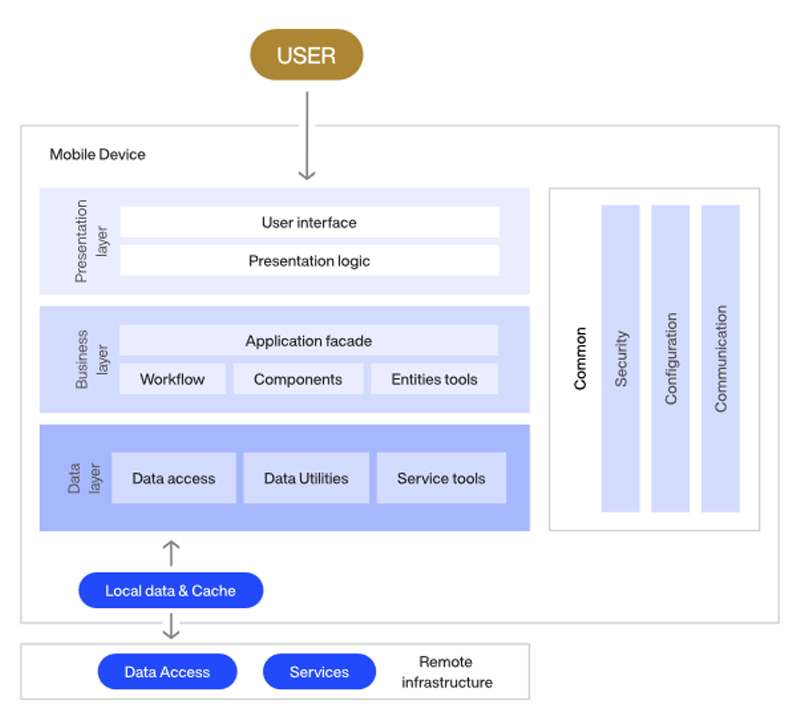No products in the cart.
 In today’s rapidly changing mobile app development landscape, creating a scalable and reliable mobile app architecture is crucial for building successful applications. As businesses increasingly leverage mobile solutions to enhance customer engagement and streamline operations, it becomes essential for developers, product managers, and CTOs to understand the key components and design patterns of modern mobile app architecture.
In today’s rapidly changing mobile app development landscape, creating a scalable and reliable mobile app architecture is crucial for building successful applications. As businesses increasingly leverage mobile solutions to enhance customer engagement and streamline operations, it becomes essential for developers, product managers, and CTOs to understand the key components and design patterns of modern mobile app architecture.
This comprehensive guide covers the fundamental aspects of mobile app architecture, including its types, components, and best practices for building high-performing, secure, and scalable mobile applications that stand out in 2025.
What is Mobile App Architecture and Why it Matters
Mobile app architecture provides a systematic structure that dictates how components communicate and how data is transferred across the application’s layers. This architectural foundation is essential for supporting high performance, scalability, maintainability, and security
A well-planned mobile app architecture enables developers to:
- Develop apps that scale efficiently as the user base grows.
- Update and maintain applications with minimal disruption.
- Ensure robust security and data integrity.
- Integrate seamlessly with backend services and third-party APIs.
- Provide superior user experiences with responsive and fast interfaces.
Neglecting a solid architecture can lead to performance issues, security risks, and expensive reworks.
Core Types of Mobile App Architecture in 2025
Choosing the appropriate architecture model is essential and should align with the app’s purpose, complexity, and long-term objectives. Below are some of the most popular mobile app architecture models used today:
- Monolithic Architecture: In this conventional model, the application is built as a single cohesive structure, with tightly integrated components encompassing the UI, business logic, and data access. Although it simplifies the early stages of development, the architecture can become increasingly difficult to manage and scale over time.
- Layered (N-tier) Architecture: Divides the application into layers such as presentation (UI), business logic, and data access. This separation helps manage complexity and enhances maintainability. Each layer can evolve independently, facilitating safer and more straightforward updates.
- Microservices Architecture: Breaks down the application into smaller, loosely connected services that communicate via APIs. Microservices are individually responsible for specific tasks and operate independently, enabling scalable architecture and promoting agile, efficient development processes
- Event-Driven Architecture: Focuses on processing events asynchronously, making it ideal for real-time applications like messaging or trading platforms.
- Serverless Architecture: Developers concentrate on writing code without worrying about server management. Cloud providers handle server infrastructure automatically, which reduces operational complexity and supports automatic scaling.
Key Components of Effective Mobile App Architecture
Building a robust mobile application requires integrating several core components:
- User Interface (UI) Layer: Manages data presentation and user interactions. Prominent development frameworks such as Flutter, React Native, and SwiftUI are commonly utilized for building modern mobile applications.
- Business Logic Layer: Encapsulates the core functionality and decision-making processes within the app.
- Data Layer: Manages data storage, retrieval, and synchronization. Using databases like SQLite or Realm with backend API integration ensures data consistency.
- Network Layer: Handles communication between the application and backend services via RESTful APIs or GraphQL.
- Security Layer: Enforces authentication, authorization, and data encryption, protecting against threats like data leaks and injection attacks.
- Integration Layer: Connects the app with third-party services, analytics, and cloud platforms.
Visualizing the Mobile App Architecture
Here’s an original diagram that illustrates the main layers of mobile app architecture for better clarity:

Mobile App Architecture 2025: Trends and Challenges
- Cross-Platform Compatibility: As users access apps on various devices, frameworks like Flutter and React Native enable developers to build consistent experiences, but they also introduce architectural challenges.
- Edge Computing and AI Integration: Integrating edge computing with AI enhances data processing near the user, enabling real-time insights and personalized features.
- Zero Trust Security: Implementing a zero trust model strengthens app security by verifying every access request.
- Leveraging 5G Connectivity: Apps designed to take advantage of 5G networks can offer low-latency and high-bandwidth experiences.
- Enhanced Offline Capabilities: Users expect apps to work seamlessly even without an internet connection, necessitating robust local caching and synchronization mechanisms.
Why Choose actsupport.com for Your Mobile App Architecture Needs
At actsupport.com, we deliver comprehensive mobile app architecture solutions that meet modern demands for performance, scalability, and security. Our team of experts designs custom architectures tailored to your industry, ensuring your application is future-ready.
- Expert Design and Implementation
- Security-Focused Development Practices
- Comprehensive Post-Launch Support
Connect with us to build a robust mobile application architecture that aligns with your business goals and ensures long-term success.
📌 Power Your Applications with Confidence
actsupport delivers expert Application Hosting Support tailored to your business needs—ensuring performance, availability, and 24/7 reliability.
Stay updated! Follow us on social media! Facebook, Twitter, LinkedIn
Check out our newest blog entry (Containers vs VMs: What’s the Right Choice?)
Subscribe to get free blog content to your Inbox


